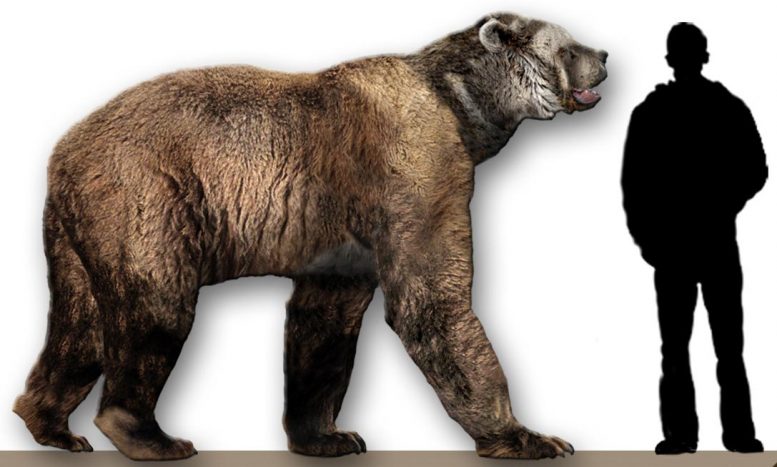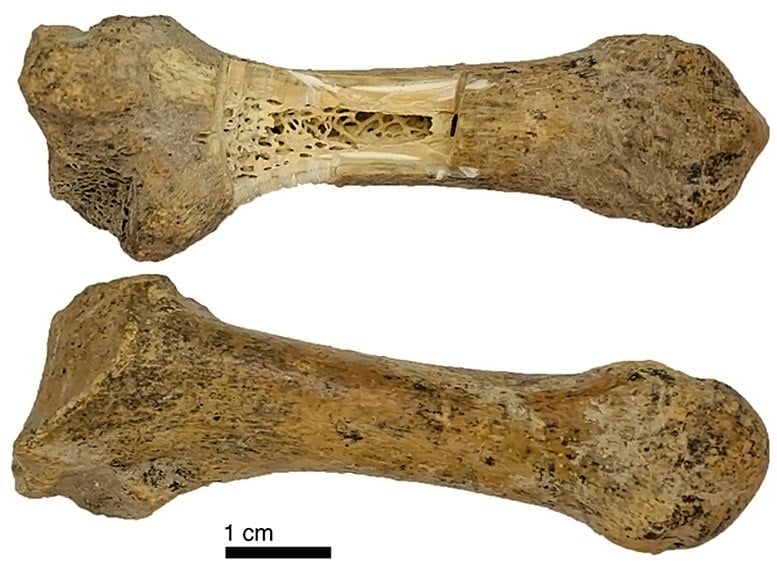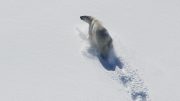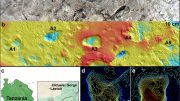
Arctodus simus reconstruction compared to a human. Credit: Dantheman9758 / Wikimedia Commons CC BY-SA 3.0
The California Channel Islands are renowned for their archaeological, biological, and paleontological significance and richness, containing some of the most important early human sites in North America. This importance is only growing with new excavation, chemical, and biomolecular techniques, expanding our vision of this dynamic ecosystem and its enduring importance to humans and wildlife alike.
Today, a team of researchers from the University of Oklahoma, the Smithsonian National Museum of Natural History, the University of Oregon, and others report the first occurrence of the extinct giant short-faced bear, Arctodus simus, from the California Channel Islands. This fearsome beast — weighing by some estimates 2,000 lbs (900 kg). — once roamed diverse environments from Alaska to Mexico, but has never been found in such an isolated island context. While this is not the first strange mammal to be found on the California Channel Islands, which was once home to a pygmy mammoth and a giant mouse, it is the first case of a potentially native megafaunal carnivore, which would challenge previous models of colonization and evolution of the islands’ biodiversity.
This little bone, excavated in 1996, was long assumed to be from a seal, but experts suggested that it was from a bear — the first and only bear ever recorded for California’s Channel Islands.

Two views of the short-faced bear toe recovered Daisy Cave, San Miguel Island, California Channel Islands (University of Oregon #514-6778). The cut bone indicates where samples were taken for DNA, radiocarbon and protein analysis. Credit:
Excerpted from Figure 2, from: Mychajliw et al. 2020. Biogeographic problem-solving reveals the Late Pleistocene translocation of a short-faced bear to the California Channel Islands. Scientific Reports, http://www.nature.com/articles/s41598-020-71572-z
“Found in a stratum dated to over 13,000 years ago, the bone posed a significant mystery,” said Jon Erlandson, a University of Oregon professor who has directed investigations at Daisy Cave since the 1990s. Was it from a large grizzly or black bear? The specimen rested safely in Erlandson’s lab for more than 20 years.
In 2016, the toe bone arrived at the Laboratories of Molecular Anthropology & Microbiome Research at the University of Oklahoma.
“From the moment I heard this could be a unique specimen, I handled it with extra care. I remember having a hard time cutting the bone piece out; it was such a rigid, morphologically well-preserved sample, thanks to the cave’s environment. Luckily, its DNA was well-preserved, too,” said Nihan Dagtas, who successfully extracted amplifiable DNA at the world-class clean room facility of LMAMR.
In parallel, the specimen was analyzed for ancient bone proteins (collagen) at the University of Manchester in the UK, producing chemical fingerprints that most closely matched a reference of the spectacled bear from South America — the only living relative of the short-faced bear. These two independent molecular analyses, combined with traditional morphological evidence of the shape and size of the toe, confirmed its identity as belonging, unexpectedly, to a giant short-faced bear.
Torben Rick, who participated in the Daisy Cave excavations and is now at the Smithsonian’s National Museum of Natural History, was excited to apply a suite of new, minimally destructive technologies (aDNA, proteomics, etc.) to help resolve the questions surrounding this mysterious bone. “When the results came back that this was a short-faced bear dated to roughly 17,000 years ago, we were all really intrigued about the implications for island biogeography and ecology,” said Rick.
Researchers were puzzled at first — what was a giant short-faced bear doing so far away from its known range on the California mainland? They developed a set of hypotheses to test whether it arrived at the island before or after death, and weighed the evidence.
If the bear died on the island, it might imply that a native population of short-faced bears swam to the islands and evolved over thousands of years alongside the pygmy mammoths. Or did a single individual swim to the island in search of a snack? The researchers suggest that a “pre mortem” arrival of the toe was unlikely, as it is the only specimen from the species ever found on the islands, and bears that die in caves are usually found intact.
Then, researchers turned to a “post mortem” hypothesis: the toe was brought to the island by something or someone. “A human transport of the toe bone seems unlikely given its age and excellent preservation, but numerous animals — condors, eagles, seagulls, and others — are known to scavenge and transport bones and shells in coastal areas,” Erlandson said.
The research team suggests that the most likely mode of transport was by wing. Chemical analyses known as stable isotopes indicate that this bear was feeding opportunistically on marine mammal carcasses, perhaps putting it at the right time and right place for its own carcass to eventually be scavenged by a bird, such as a California Condor or bald eagle.
“We were able to integrate interdisciplinary toolkits, including morphology, ancient DNA, collagen fingerprinting, radiocarbon dating, and stable isotopes, to develop a robust hypothesis testing framework allowing us to explore the origins of this mysterious bone,” said Courtney Hofman, assistant professor of anthropology at the University of Oklahoma, co-director of LMAMR, and senior author of the study.
Despite once being so widespread, there is significant debate over the ecology and behavior of short-faced bears, and available data are sparse. Previous studies relying on tooth shape and cavities suggested that short-faced bears from Los Angeles’ famed La Brea Tar Pits ate large amounts of carbohydrates, whereas other studies using stable isotopes suggested the species relied on animal protein in Alaska and Canada. Surprisingly, this toe was the first specimen to test dietary hypotheses in the same way in California.
“This little toe helped us lay the groundwork for addressing some big questions in paleontology,” notes Alexis Mychajliw, a postdoctoral research associate at the University of Oklahoma, research associate at the La Brea Tar Pits, and lead author of the study. “Southern California was packed with large carnivores 17,000 years ago, and it’s possible that the opportunistic use of marine resources helped short-faced bears survive some tough competition. That is, until climates changed, and humans arrived.”
Reference: “Biogeographic problem-solving reveals the Late Pleistocene translocation of a short-faced bear to the California Channel Islands” by Alexis M. Mychajliw, Torben C. Rick, Nihan D. Dagtas, Jon M. Erlandson, Brendan J. Culleton, Douglas J. Kennett, Michael Buckley and Courtney A. Hofman, 16 September 2020, Scientific Reports.
DOI: 10.1038/s41598-020-71572-z









17,000 years ago sea level was at least 100 meters lower than today, and the Channel Islands were essentially a single land mass larger than today. The distance to the mainland was about half what it currently is and might not have been a serious impediment to a large bear, considering the distances polar bears are known to swim in much colder water.
Cool – this is not the only island bear find doing the rounds, here is another bear from islands lying tens of kms from the mainland: https://www.bbc.com/news/world-europe-54160645 .
(And what Clyde said on distances – the Siberian bear may have arrived on ice and/or when the sea level was lower (the carbon dating isn’t terribly exact for some reason, maybe the permafrost conditions which else preserves isn’t good for such datings).
According to Google Earth, the waters around the island where the frozen bear was found are quite shallow — less than 30 meters. The islands were almost certainly connected to the mainland 30,000 years ago, and only became islands with the rise of sea level after the continental glaciers melted.